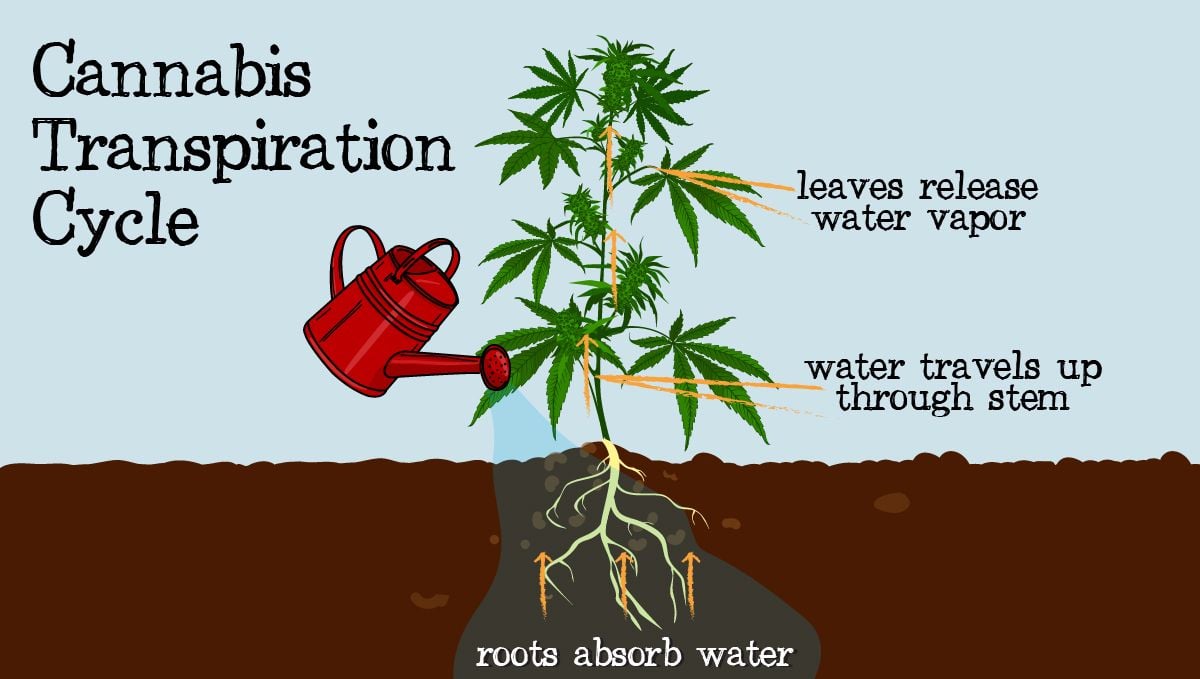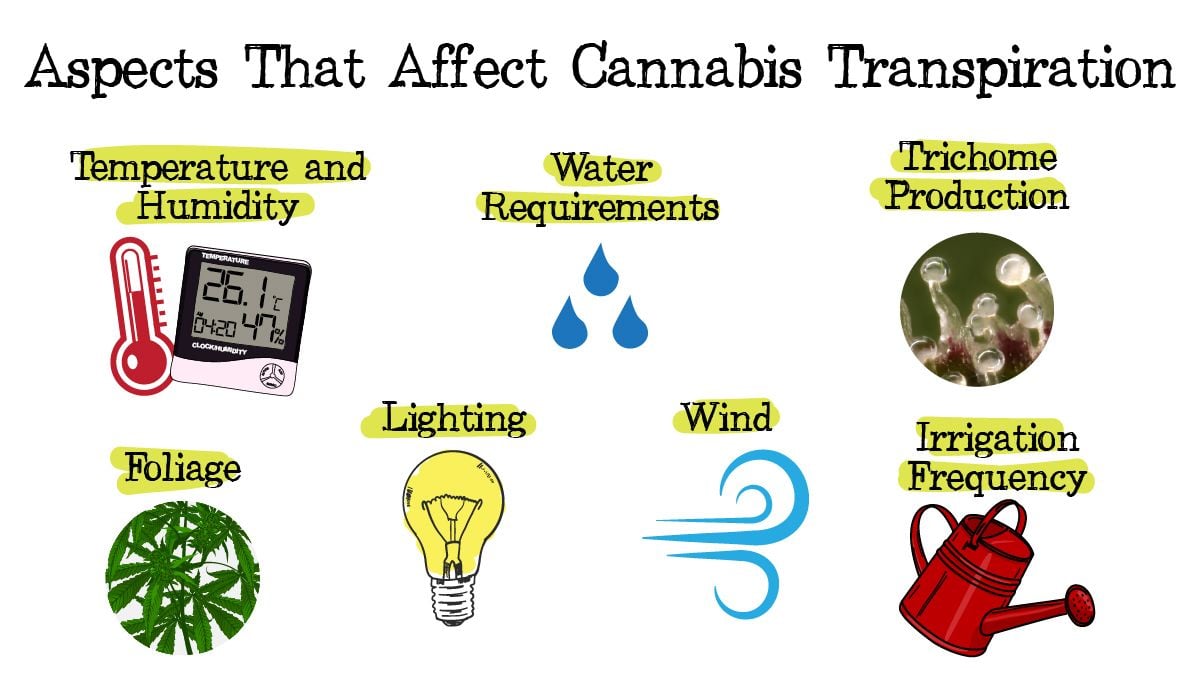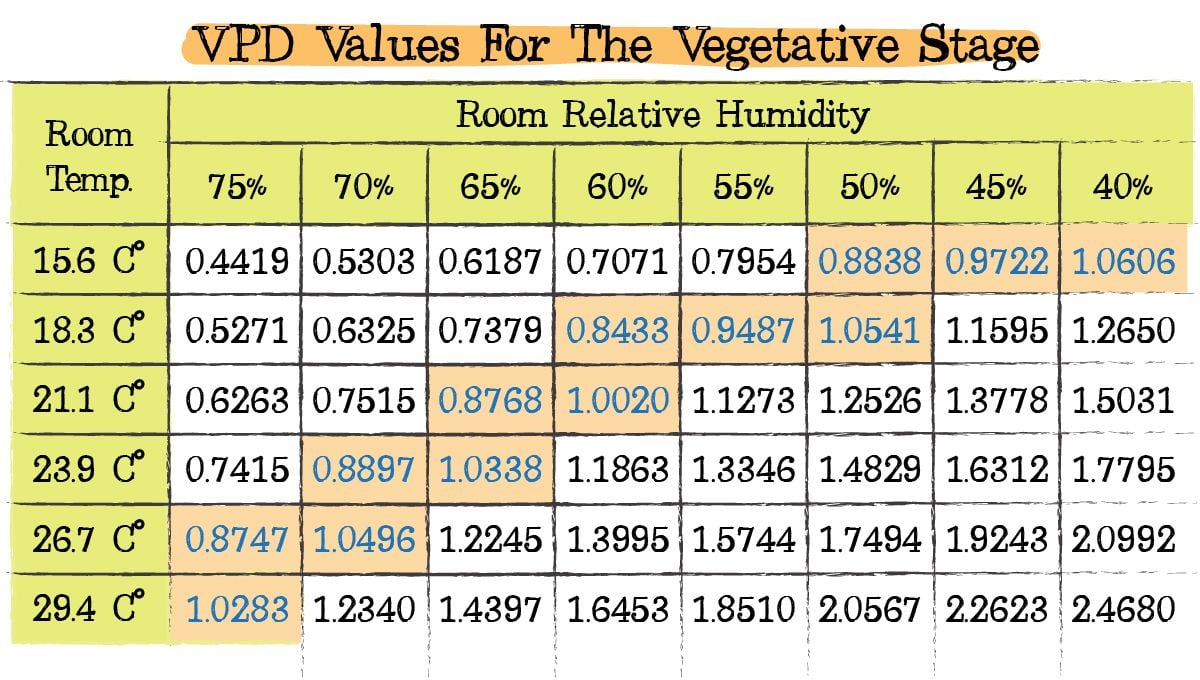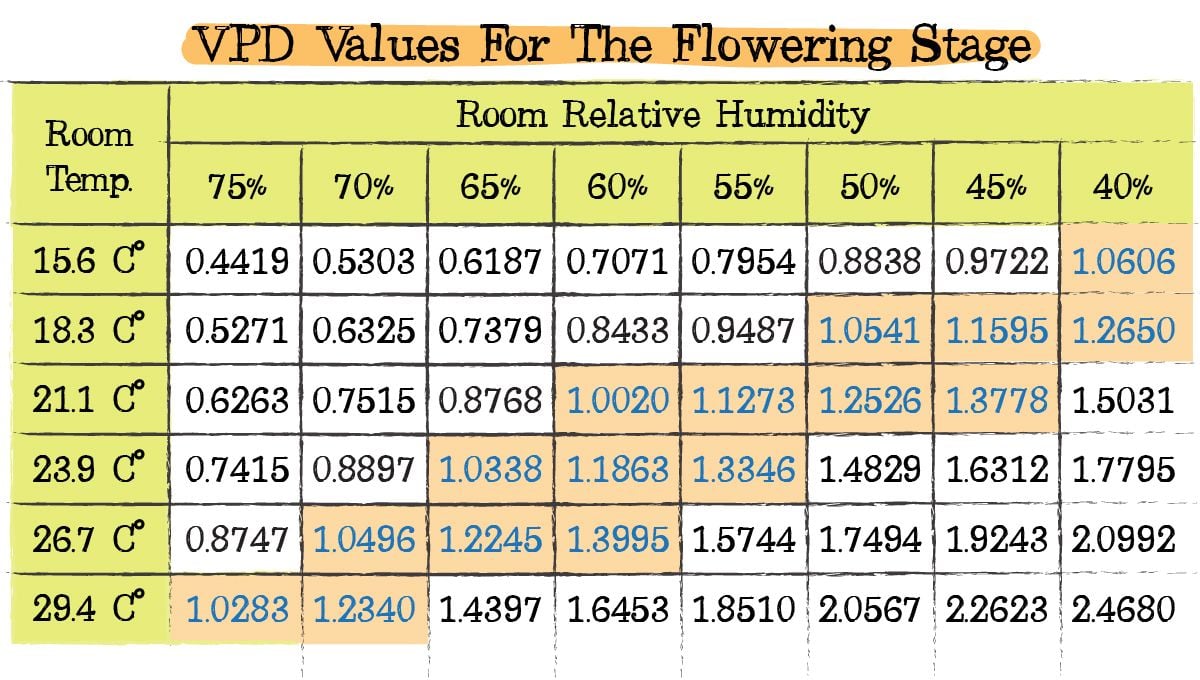Cannabis Transpiration: How to Improve Plant Growth

- 1. Understanding cannabis water use
- 2. Does transpiration affect the growing conditions?
- 3. How does transpiration work?
- 4. The ideal conditions for cannabis transpiration
- 5. Vpd and transpiration rates
- 6. In conclusion
Transpiration has two main functions: moving nutrients from the roots to the leaves and cooling down your plant, this means that controlling the transpiration rate can help you improve plant growth. In order to maintain conditions between the ideal range, growers need to keep a close eye on the conditions or use sensors that can adjust the conditions if they’re outside of the ideal range, allowing you to get the best possible plant growth. So read along to understand cannabis seeds' transpiration and learn about the ideal conditions!
1. Understanding Cannabis Water Use
All plants, including cannabis plants, need lots, lots of water to grow healthy. All the water cannabis plants absorb eventually evaporates and make its way into the air via a process called transpiration. The growing conditions should be checked and adjusted daily as it affects transpiration rates and can also help prevent mold issues. Controlling humidity leves in an indoor tent can be difficult but it’s essential for plant health, this means that when growing cannabis, you need to take water uptake and transpiration very seriously. Unfortunately, it’s impossible to say exactly when to water your cannabis plants as there are a lot of variables that not only affect the amount of water your plants need but also how often you should water them. These variables include things such as room size, temperature, humidity levels, plant size, substrate, and light intensity among others.
This means that all these factors will dictate how much water you use and how often you have to water. Once you finish a couple of grow cycles in the same grow tent you’ll be able to get a better idea of how much water to use and how often to water. But if you’re wondering how much you need, commercial growers calculate that you’ll need around 11 liters of water for every square meter of grow space.
But your crop may not need this much water, although it’s better to be safe and sorry. So when growing at home, make sure to have enough water but always pay attention to the environment and other variables mentioned in order to create and perfect your irrigation routine and technique. Now that you know how much water your plants may need and what affects the amount of water, let’s learn more about transpiration.
All of this talk about watering clearly shows that growers need to pay special attention to this variable during all stages of the growing cycle. Too much water can lead to pooling in the growing medium. This occurs when excess water fills the pores between soil particles; it has the tendency to remain stagnant in soil that lacks proper drainage. When this occurs, roots struggle to uptake oxygen. Plus, anaerobic organisms (those that thrive without oxygen) begin to claim ground and may result in diseases. In contrast, too little water can cause the soil to completely dry out, which has a detrimental effect on both plant roots and the surrounding soil organisms that they need to thrive.
So, surely cannabis plants make the best use possible out of all this hard work on the part of the grower, right? Well, it might surprise you, but your weed plants only use a very small portion of the water they uptake for growth and metabolic functions. This water aids in cellular processes and also contributes to turgor (uprightness) in plants by filling vacuoles in cells. So, what happens to the other 97% of water uptaken by the roots? It’s simply lost through transpiration. It makes its way up the xylem (the vascular structure responsible for moving water and nutrients through plants) and out through the stomata.
2. Does Transpiration Affect The Growing Conditions?
Transpiration is the process in which nutrients and water move from the roots through the entire cannabis plant. Understanding temperatures and humidities, and how it affects transpiration are essential if you want to achieve maximum plant growth. The transpiration process plays a huge role in maintaining the right conditions in your grow space because the growing conditions affect the metabolic processes cannabis plants perform, affecting yields and bud quality. So apart from having the conditions on point, you also have to understand how these conditions affect transpiration among other processes.

A misconception among growers is that transpiration affects the humidity in a grow room but in fact, it’s the other way around. The growing conditions actually affect the cannabis plants’ ability to transpire, due to affecting transpiration, the conditions should always be stable and never oscillate, independent of what happens in the grow room. But before learning about the ideal conditions and how to maintain them in the ideal range, let’s learn about transpiration.
3. How Does Transpiration Work?
In the transpiration process, water and nutrients are transported from the roots up the xylem, and then into the cells inside the leaves. The cannabis leaves have tiny pores (called stomata) through which water evaporates into the air, and this happens because transpiration is necessary in order for plants to release CO2 (a byproduct of photosynthesis) and also cool down when the temperatures are too high.
Now, the stomata are not always open. Plants can regulate transpiration by opening and closing the stomata depending but the opening and closing of the stomata are also influenced by the growing conditions. The only problem is, plants can lose too much water, which can result in stress, slow down the metabolic processes (including transpiration), and in extreme cases, die. Here are the main elements that can affect transpiration in cannabis plants:
Foliage
Stomata are on the leaves, this means that the bushier your plant is, the more stomata it will have, resulting in more water loss, this is why defoliation is a good practice when dealing with bushy strains.
Water Requirements
Due to genetics, some plants can have more stomata than other plants, even if they don’t produce as many leaves. In this case, the plant will lose water at a faster rate so you’ll have to water it more often or with more water to avoid slowing down growth.
Trichome Production
Trichomes production can also affect transpiration because they help prevent excessive transpiration by holding humidity on the leaf's surface.

Lighting
The stomata usually open when the environment is cooler, which is usually at night. This happens because, if the stomata open during hotter temperatures, more water will evaporate, meaning that stronger lights can increase transpiration rate, thus resulting in more water loss.
Temperature and Humidity
Temperature and humidity are super important for transpiration because water evaporation increases when temperatures rise and when the humidity levels are lower.
Wind
Wind moves vapor away from around the plant, causing plants to transpire more. You should definitely have fans in your grow room but make sure they’re not too strong.
Irrigation
Irrigation also affects transpiration rates. When the soil is too dry, cannabis plants close the stomata to avoid losing too much water but doing this results in a CO2 build-up inside the plants which can result in death.
4. The Ideal Conditions For Cannabis Transpiration
As you’ve read, almost all elements present in cannabis growing can affect transpiration, this means that you should control the growing conditions very closely if you want your plants to reach their full potential but controlling the conditions is hard for those who don’t have the necessary equipment.
Luckily, there’s no need to buy expensive equipment if you’re a home grower, by using relatively cheap equipment such as
- Dehumidifier;
- Humidifiers;
- Fans and;
- Exhaust fans.
You can control the elements that affect transpiration and, if you want to have even more control, you can use
- Air conditioner and:
- Heater.
To be able to maintain the ideal conditions during summer or winter. In general, the temperature and humidity you should aim for are the following:
Ideal Conditions For Cannabis By Stage
| Stage |
Temperature (lights ON / lights OFF) |
Humidity |
|---|---|---|
| Seedling | 20 - 25 °C / 15 - 20 °C | 65 - 70 % |
| Vegetative | 22 - 28 °C / 17 - 23 °C | 45 - 70 % |
| Pre-flower/Flower | 20 - 26 °C / 15 - 21 °C | 40 - 55 % |
| Late Flower | 18 - 24 °C / 13 - 19 °C | 50 - 55% |
The equipment mentioned is relatively cheap and even if you don’t follow the conditions mentioned, you can still grow great flowers so it’s not obligatory. But commercial growers can’t afford to risk their crops and need to grow the best flowers possible in order to be relevant in the cannabis market. So they have to use HVAC systems and control the VPD closely in order to maintain perfect conditions from seed to harvest.
“HVAC refers to Heating, Ventilation and Air Conditioning systems used for air exchange between indoors and outdoors, heating and cooling in commercial grow operations.”
5. VPD and Transpiration Rates
VPD refers to the difference between the vapor pressure of the air surrounding a cannabis plant and the pressure inside the plant. This means that the VPD is basically responsible for dictating transpiration rates, which impacts plant growth directly. As mentioned, transpiration is the process that allows water and nutrients to move from the roots to the leaves and branches while also helping them regulate their temperature and release CO2 produced by photosynthesis through the stomata.
Based on this, growers can adjust VPD levels to achieve perfect plant growth. For example, if VPD levels are too low, peak transpiration rates are not possible so plants are more prone to suffer from mold. On the other hand, in high VPD levels, the plants close the stomata in an attempt to not lose too much water and can result in “clawed” leaves or burnt tips. Just like the conditions shown in the table above, VPD is used to keep growing conditions in between the ideal ranges but with much more precision and, in combination with crop steering and an irrigation plan, it allows you to control every single aspect (as much as possible) of plant growth. The VPD during the vegetative stage ranges from 0.8 - 1.1 kPa while the ideal VPD for the flowering stage ranges from 1.0 - 1.5 kPa, as you can see in the following tables.

As you can see in both tables, you can achieve ideal VPD values with different temperatures and humidities, this means that you can still grow great flowers with higher or lower temperature or humidity levels. Meaning that, in order for plants to thrive, the VPD needs to be at a certain level, which changes for every stage of plant growth so it’s not a matter of always maintaining the same growing conditions but having the equipment necessary and knowing when to increase or decrease temperature and humidity levels.

Once you’re able to do it either with commercial or household equipment, you’ll get consistent growth because a consistent temperature and humidity results in a consistent VPD, which maintains a consistent transpiration rate and results in perfect plant growth.
6. In Conclusion
Proper equipment is necessary for growers to keep consistent growing conditions so truly understanding the cannabis plant’s basic processes is the key to knowing how to choose and use the best equipment for your grow room. Plant growth is directly affected, either positively and negatively, by the growing conditions so if you want to get the best possible plant growth, making small changes in temperature and humidity for each stage of plant growth is vital. If you want to share tips to help fellow growers get the best plant growth possible, feel free to leave a comment in the comment section below!













Comments